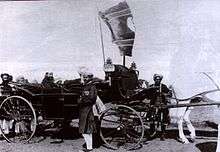Viqar-ul-Umra
| Viqar-ul-Umara, Iqtidar ul-Mulk, Iqbal ud-Daula, Nawab Sir Muhammad Fazl-ud-Din Khan Bahadur Secundar Jung, KCIE, Kaiser-i-Hind | |
|---|---|
| Born |
13 August 1856 Hyderabad, Hyderabad State India |
| Died |
15 February 1902 (age 45) Yalghadap-Khanapur, Hyderabad-Deccan, Hyderabad State India |
| Burial place | Paigah Tombs, Hyderabad |
| Residence |
Shahgunj City palace (1856 - 1891),Falaknuma Palace (1891-1897), Aiwan-e-Begumpet also known as Aiwan-e-Begumpet or Paigah Palace of Begumpet (1897-1902) |
| Spouse(s) | Lady Vikar ul Umra (Princess Jahandar un-nisa Begum), Muneer Un-nisa Begum, Dr. Gul Bai Vicajee |
| Children | Nawab Sultan ul Mulk Bahadur, Nawab Wali ud Dowla, Sahibzadi Liyaqat un-nisa Begum, Sahibzadi Tabarak un-nisa Begum |
| Parents |
|
| Relatives |
Asman Jah (cousin) Asaf Jah VI (brother-in-law) Asaf Jah V (father-in-law) |
| Family | Paigah family |
| Prime Minister of Hyderabad | |
|
In office 1893–1901 | |
| Monarch | Asaf Jah VI |
| Preceded by | Nawab Asman Jah |
| Succeeded by | Maharaja Sir Kishen Pershad |
| Amir-e-Paigah | |
|
In office 1881–1902 | |
| Preceded by | Nawab Raheeduddin Khan Bahadur |
| Succeeded by | Nawab Sultan ul Mulk Bahadur |
Sir Viqar ul-Umara, Iqtidar ul-Mulk, Iqbal ud Dowla, Secundar Jung, Nawab Muhammad Fazl ud-din Khan Bahadur, KCIE (13 August 1856 – 15 February 1902) served as the Prime Minister of Hyderabad from 1893 to 1901 and Amir e Paigah 1881 to 1902.[1]
The town of Vikarabad is named after him.
Personal Life
Vicar ul-Umra married Jehandarunnisa Begum, daughter of Asaf Jah V and sister of Asaf Jah VI. She took the title of Lady Vicar ul-Umra when her husband was knighted.[2]
Tenure as prime minister


During his years as prime minister, he made valuable contributions in the field of education. The education department, the engineering school, the law classes, the legislative Council and the Asafia Library were opened under his prime-ministership.[3]
He was the fifth Amir of a noble family, the Paigahs, and was the maternal grandson of Asaf Jah III.
Sir Muhammad Fazl ud-din built the magnificent palace like Falaknuma Palace as his residence, which took 9 years to build, and was completed in 1893.
He also built the magnificent Paigah Palace in the European style of architecture, after he gave the Falaknuma palace to Mahbub Ali Khan, Asaf Jah VI, where he spent his life. He built Vikhar Manzil, near Hussain Sagar lake.
Fazl ud-din was an avid polo player and is credited with bringing the game Hyderabad state. His interest grew after his visit to Europe where he saw polo played by the wealthy. After coming back to Hyderabad, he helped build some 17 polo grounds. He hosted polo tournaments and invited noble families to participate, captaining the Paigah team.
Notes
- ↑ Lynton, Harriet Ronken; Rajan, Mohini (1974). The Days of the Beloved. University of California Press. pp. 83–105. ISBN 0-520-02442-7.
- ↑ Lynton, Harriet Ronken; Rajan, Mohini (1974). The Days of the Beloved. University of California Press. pp. 83–105. ISBN 0-520-02442-7.
- ↑ A Blog on Paigahs
References
- Lynton, Harriet Ronken; Rajan, Mohini (1974). The Days of the Beloved. University of California Press. pp. 83–105. ISBN 0-520-02442-7.
External links
| Government offices | ||
|---|---|---|
| Preceded by Nawab Asman Jah Bahadur |
Prime Minister of Hyderabad 1893–1901 |
Succeeded by Maharaja Sir Kishen Pershad |